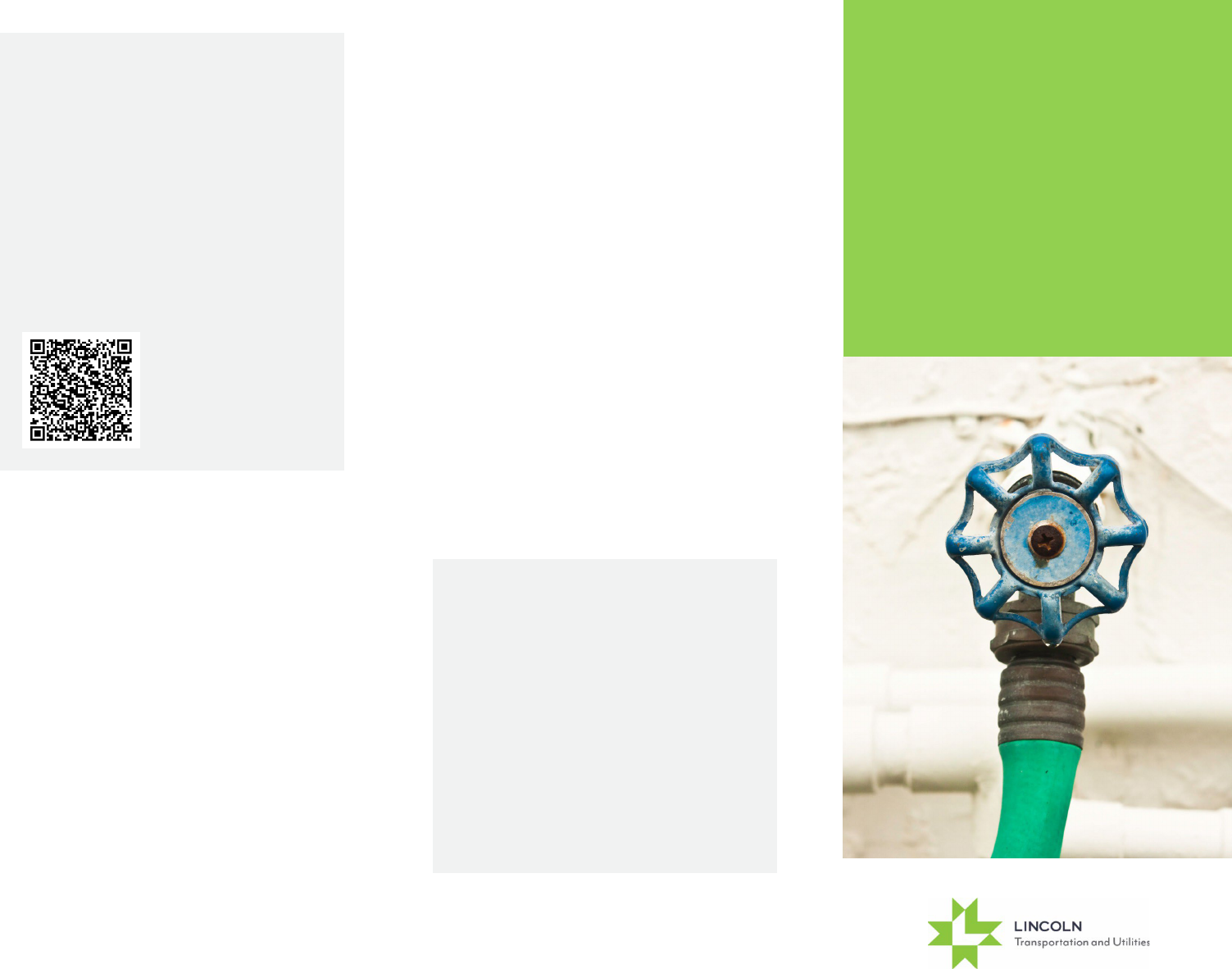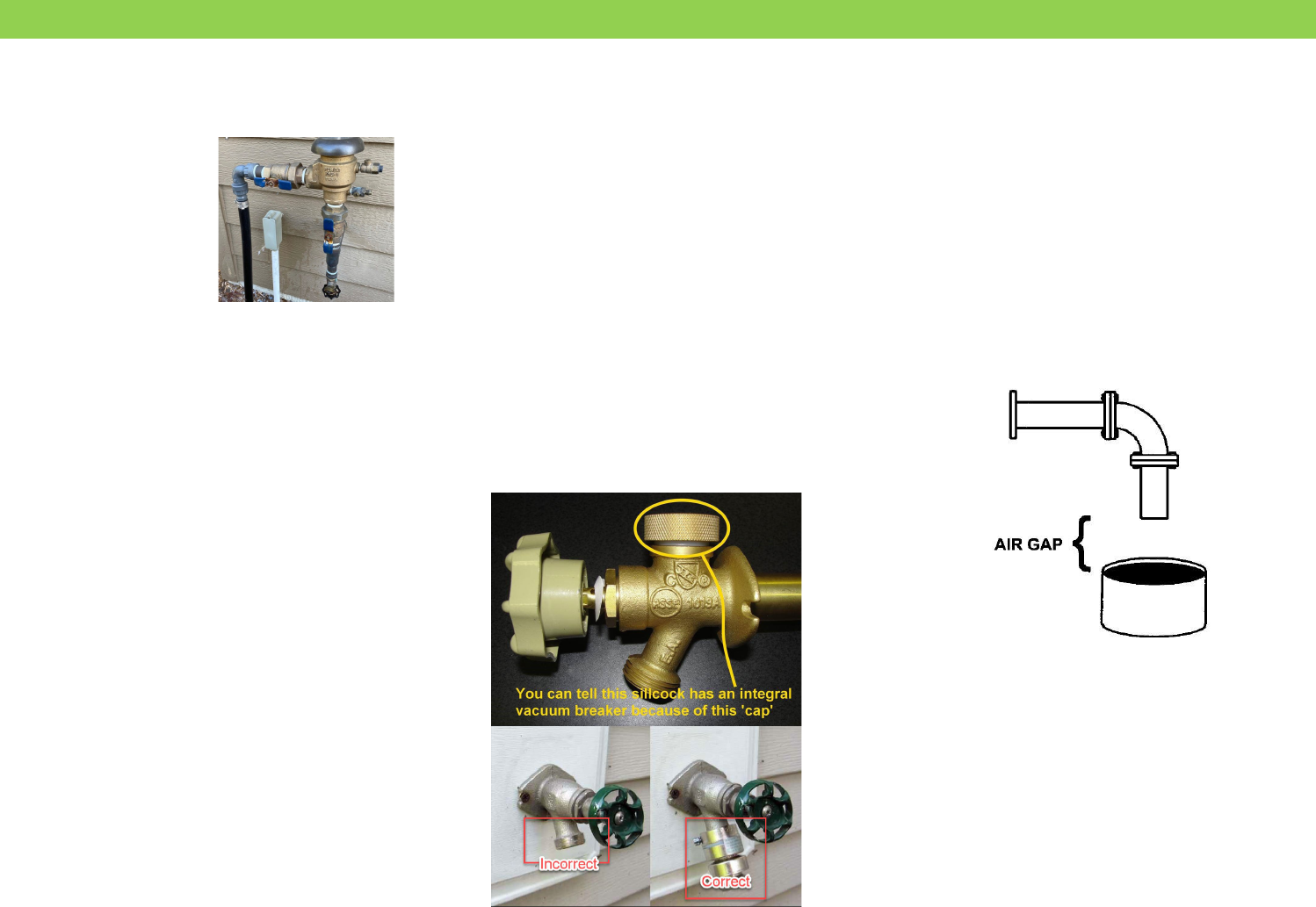
Contact Us
Lincoln Water System
201 North 27
th
Street
Lincoln, NE 68503
Not sure if you need a backflow
device? Need more information on
what type of backflow prevention
devices you may need?
Call our office 402-441-5912 between
7:30 a.m. and 4 p.m. to speak with a
Cross Connection Technician or call your
local licensed plumber.
What is a cross connection and why
is it important to me?
A cross connection is defined as an actual or
potential connection between the public
water supply and a source of possible
contamination or pollution. All homes have
potential cross connections. The water pipes
and plumbing fixtures that make up cross
connections can be the link for contamination
to get into the drinking water supply. Water
pressure can suddenly drop because of heavy
usage, a water main break or fire in the area.
When that happens, contaminated water
(backflow) could be siphoned back into
your plumbing system from an unprotected
cross connection within your home. Even
though Lincoln has a very reliable water
distribution system, these pressure drops
occur somewhere in the city almost every
day. The result of back siphonage is that
chemicals, poisons, and bacteria might find
their way back into the water you drink if you
are not proactive to avoid or protect your cross
connections.
Cross Connection Control Program
Lincoln Water System is required by Nebraska
Department of Environment and Energy to
conduct a cross connection control program
using the specific components below:
• A survey and inspection every five years
of each home and building connected
to the public water supply. Inspections
of the plumbing system by the property
owner or tenant are required to determine
if backflow hazards, or cross connections
exist. Water customers should report any
cross connections to Lincoln Water System
by completing the Residential Plumbing
Cross Connection Survey.
• A public education program to inform
water customers of the potential harm
that plumbing cross connections can
cause to the public water supply. To learn
more, visit lincoln.ne.gov/backflow.
• Installation of backflow protection
devices. Installing backflow protection
on cross connections safeguards the
public water supply. Not sure if you need a
backflow device?
• Annual testing of backflow preventers.
Testing backflow devices, by a certified
tester, ensures proper operation and is
required yearly.
Residential Plumbing Cross
Connection Survey
Help us keep Lincoln’s drinking water
safe by eliminating unprotected cross
connections! One way to do this is
by completing the Residential Cross
Connection Plumbing Survey.
This brochure will help guide you in
how to answer the questions on your
Residential Cross Connection Plumbing
Survey. The numbers in the brochure
correspond with the numbers on the
survey.
Scan the QR code
to complete the
survey online. If you’d
prefer to print the
survey and mail it in,
visit lincoln.ne.gov/
backflow.
CONNECTIONS
HOW TO DETERMINE IF YOU HAVE A
RESIDENTIAL CROSS CONNECTION
CROSS
RESIDENTIAL
PLUMBING

Residential Cross Connection Types
This brochure will help guide you in how to answer the questions on your Residential Cross Connection Plumbing Survey. The numbers in the brochure correspond
with the numbers on the survey.
1. Lawn Irrigation Systems
Underground
irrigation systems
are a direct cross
connection. A
suitable backflow
device, typically
located on the
side or back of
your home, must
be used to protect
the public water supply. Surface water can
be siphoned back into your plumbing system
through an automated lawn irrigation system
unless a proper backflow device is attached.
If the system uses a pump or has fertilizer
or chemical injection, additional backflow
protection and testing is required.
2. Private Wells and Secondary Water
Sources
A well or secondary water source on a property
is a potential cross connection. Wells or
secondary water sources are prohibited from
being connected to the Lincoln Water System.
A backflow preventer on the public water
supply is always required at the meter when
secondary sources of water are present on a
customer’s property.
3. Swimming Pool or Hot Tubs
Pools and hot tubs that are permanently
connected to the home plumbing systems
are direct cross connections and must be
protected with a suitable backflow device. An
unprotected cross connection could draw pool
water and chemicals back into your household
plumbing system and public water supply.
When filling a pool or hot tub with a hose,
never submerge the end, as this is another
cross connection. Always leave an air gap when
filling pools, hot tubs, sinks or containers.
4. Home Medical, Dental or Dialysis
Equipment
Similar to equipment found in medical offices,
these devices are sometimes used in the
home. When connected to the water supply,
these cross connections must be protected
with a suitable backflow device to prevent
contamination of the home plumbing system
and public water supply.
5. Boiler Systems for Heating
These systems are not common but do exist,
normally in larger homes. Water is used to
replenish the boiler, which may also have
chemicals. This cross connection must be
protected with a reduced pressure principle
backflow device to prevent contamination of
the home plumbing system and public water
supply.
6. Other Suspected Cross Connections
A garden hose is the most common cross
connection. A garden hose submerged in
water in a sink or container with chemicals
or fertilizer is a serious cross connection. A
sudden drop in water pressure from a water
main break or from water being used to fight
a fire can siphon water back into your home
plumbing system or the public water supply.
A vacuum breaker is a simple and inexpensive
device that can be installed on the faucet or
hose to prevent contamination. Never leave the
end of a hose submerged in a tub, sink, pool or
container.
Most bathtubs and sinks have an air gap as
backflow prevention. This space between
the highest water level in the fixture and the
outlet of the water is the best form of backflow
protection.
Home use of photographic chemicals, process
chemicals, biological lab supplies, and other
chemicals can cause contamination due to an
unprotected cross connection. Residential fire
protection systems, in-home water treatment
systems, car washes, solar heating, soaking
tubs and decorative ponds are other possible
cross connections.
